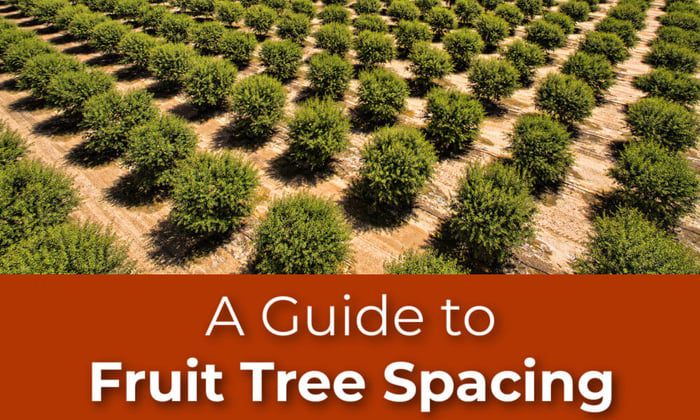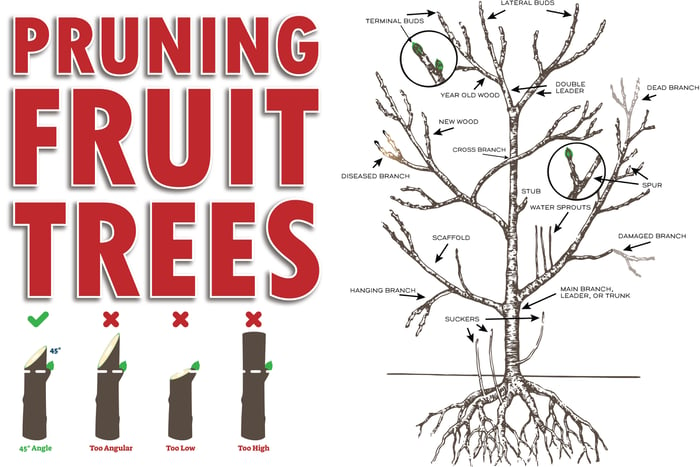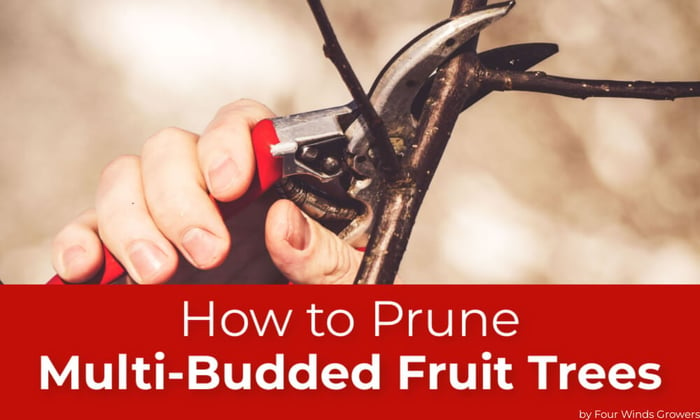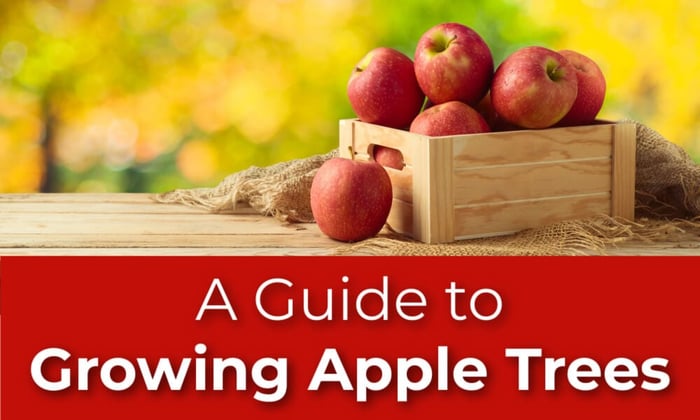When planning out your backyard orchard it is important to know your fruit tree spacing, or how far apart to plant fruit trees. It doesn't matter if you are planting one tree or one thousand, these recommendations will hopefully help you decide the best fruit tree spacing, placement, and pruning techniques for your fruit trees!
Fruit tree spacing can be manipulated in a variety of ways to suit the needs. Do you want a fruit tree hedge, distinguishable rows of semi-dwarf trees, even an espalier fruit tree wall that hides your fence or replaces it entirely? Maybe you only want to plant one tree and just want to space it out properly or allow space for a nice shade-providing fruit tree. Knowing your fruit tree variety's vigor, growth characteristics, and max size is very important when spacing out your tree's final location.
According to our fruit tree partner Dave Wilson Nursery, "Fruit tree spacing depends entirely on the grower's needs and objectives. Four- to ten-foot spacings are all common in backyard plantings. But if your goal is simply to have a steady supply of fresh fruit for family use, fruit trees planted 3-4 feet apart in groups or rows (and given summer pruning for size control) will provide plenty of fruit during their harvest period." which empowers our growers the freedom to experiment and do things their way depending on your end goal and expectations.
High-Density Fruit Tree Spacing:
-
Cordon Espalier Fruit Tree Spacing: With dwarf and semi-dwarf fruit trees being all the rage these days, there has never been a better time to throw the "my yard is too small" excuse out the window. With Cordon fruit tree growing, you can space your fruit tree as close as 18"-24" apart and at a slight angle to produce a beautiful columnar(single stem) fruit tree with short fruiting branches. This style of tree spacing/pruning is best used on spur-bearing fruit trees like apples, pears, plums, and cherries where spur varieties are available. This compact growing method involves pruning all lateral or side branching back to the closest fruit spur or about 6" away from the main trunk to maintain density. Cordon growing allows growers to have the most varieties in the least amount of space as well as space your trees out incredibly close so long as you are willing to put in the work to set them up and maintain them.
-
Horizontal Espalier Fruit Trees: This form of tree pruning involves intense training and pruning your fruit tree along a wall or trellis. This act of judicious pruning has resulted in a very similar training process as wine grapes vines on a trellis and has resulted in some very creative shapes with the same goal of creating a flat, compact, and easy to harvest fruit tree. The standard horizontal espalier can be spaced at around 4'-5' apart with branches reaching out as far as halfway between trees. Trees can also be spaced out much further apart if you have more space. This is a great way to fit a fruit tree along a fence that is not only functional but also an artistic piece in the garden. (Perfect for Apples, Pears, Plums, Cherries, and Citrus!)
-
Fruit tree Hedge: This is most common with citrus trees and is actually how many large commercial citrus growers grow their trees. Citrus tree hedges can be spaced as close as 3' apart to produce a nice dense hedge. Pruning is simple as well since you can prune with a hedge trimmer or hedge shears as you see fit. This style of pruning and spacing results in a beautiful evergreen wall but will require regular pruning to prevent the trees from getting out of hand.
-
Single Hole Planting: Two to four trees can be planted in the same hole resulting in a manageable crop of several varieties in a small space. By planting at this density, each tree should be pruned to the matching heights and kept up to prevent one variety from taking over. This will also force the trees to compete with one another for resources resulting in semi-dwarfed trees. This is a great way to get a variety of fruits from limited space without grafting. This method should be used with fruit trees that are all in the same family. You can do this with almost any fruit tree but works best with Citrus and Avocado Trees.
Row Spacing: Space the trees out by the max height of the tree and add 3-5' to account for the walkway. For example, If your fruit tree maxes out at a height of 10-15' then plant your trees 10-15' apart in the row and space your rows out 15-20' apart to allow for a walkway between the rows. This will give you a similar result to the trees pictured above. As you can see you can aim for a much closer if you don't need space to walk around each tree and aim for a 5'-10' spacing. This method of spacing is certainly the most conservative, allowing for more space around each tree but will work with every variety.
All of the mentioned spacing recommendations can be used to gauge the distance you should plant your trees to obstacles like fences, concrete walkways, as well as other trees and plants. You can also get an idea of the pruning requirements of each method to set your expectations accordingly.
Protect your fruit trees from the hot summer sun and winter cold with Plant Guard tree paint and foliar spray.
Author: Israel Osuna
Source: gardeningknowhow.com
Source: davewilson.com




